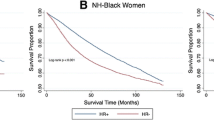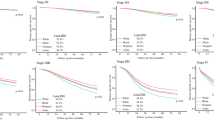Abstract
Black women are more likely to be diagnosed with advanced stage and other less favorable breast cancer prognostic factors than white women. The aim of this study was to examine the extent to which markers of socioeconomic position accounts for black–white differences in these factors. Our study included 193,969 women diagnosed with invasive breast cancers during 2004–2005 from the National Cancer Database, which represents about 72% of all patients with cancer treated in the United States. Compared to white women, black women are more likely to be diagnosed with breast tumors that are less differentiated (odds ratio (OR) = 2.55, 95% confidence interval (CI) 2.44–2.66), hormone receptor negative (OR = 2.29, 95% CI 2.22–2.37), large (OR = 1.87, 95% CI 1.80–1.95), metastatic (OR = 1.89, 95% CI 1.78–2.00), and lymph node-positive (OR = 1.44, 95% CI 1.40–1.48). In multivariable analyses, adjustment for insurance and area-level educational attainment explained 31–39% of the differences in tumor size and metastasis, but only about 14% of the differences in grade and hormone receptors. After accounting for race and other covariates, uninsured women remained 3.66 (95% CI 3.30–4.07) times more likely to have metastasis and 2.37 (95% CI 2.17–2.58) times more likely to have large tumors compared to privately insured women. Similarly, the risk of having breast cancer with less favorable prognostic factors increased as area-level educational attainment decreased. Extending health insurance coverage to all women is likely to have an effect on reducing racial disparities in the development of breast cancers with poor prognostic factors.
Similar content being viewed by others
References
Carey LA, Perou CM, Livasy CA et al (2006) Race, breast cancer subtypes, and survival in the Carolina Breast Cancer Study. JAMA 295:2492–2502
Joslyn SA (2002) Hormone receptors in breast cancer: racial differences in distribution and survival. Breast Cancer Res Treat 73:45–59
Li CI, Malone KE, Daling JR (2002) Differences in breast cancer hormone receptor status and histology by race and ethnicity among women 50 years of age and older. Cancer Epidemiol Biomarkers Prev 11:601–607
Elledge RM, Clark GM, Chamness GC, Osborne CK (1994) Tumor biologic factors and breast cancer prognosis among white, Hispanic, and black women in the United States. J Natl Cancer Inst 86:705–712
Elmore JG, Moceri VM, Carter D, Larson EB (1998) Breast carcinoma tumor characteristics in black and white women. Cancer 83:2509–2515
Krieger N, Chen JT, Ware JH, Kaddour A (2008) Race/ethnicity and breast cancer estrogen receptor status: impact of class, missing data, and modeling assumptions. Cancer Causes Control 19:1305–1318
Gordon NH (2003) Socioeconomic factors and breast cancer in black and white Americans. Cancer Metastasis Rev 22:55–65
Roetzheim RG, Pal N, Tennant C et al (1999) Effects of health insurance and race on early detection of cancer. J Natl Cancer Inst 91:1409–1415
Gordon NH (1995) Association of education and income with estrogen receptor status in primary breast cancer. Am J Epidemiol 142:796–803
Halpern MT, Bian J, Ward EM, Schrag NM, Chen AY (2007) Insurance status and stage of cancer at diagnosis among women with breast cancer. Cancer 110:403–411
Lantz PM, Mujahid M, Schwartz K et al (2006) The influence of race, ethnicity, and individual socioeconomic factors on breast cancer stage at diagnosis. Am J Public Health 96:2173–2178
Hahn KM, Bondy ML, Selvan M et al (2007) Factors associated with advanced disease stage at diagnosis in a population-based study of patients with newly diagnosed breast cancer. Am J Epidemiol 166:1035–1044
Bibb SC (2001) The relationship between access and stage at diagnosis of breast cancer in African American and Caucasian women. Oncol Nurs Forum 28:711–719
Lannin DR, Mathews HF, Mitchell J, Swanson MS, Swanson FH, Edwards MS (1998) Influence of socioeconomic and cultural factors on racial differences in late-stage presentation of breast cancer. JAMA 279:1801–1807
Wells BL, Horm JW (1992) Stage at diagnosis in breast cancer: race and socioeconomic factors. Am J Public Health 82:1383–1385
Mandelblatt J, Andrews H, Kerner J, Zauber A, Burnett W (1991) Determinants of late stage diagnosis of breast and cervical cancer: the impact of age, race, social class, and hospital type. Am J Public Health 81:646–649
Bauer KR, Brown M, Cress RD, Parise CA, Caggiano V (2007) Descriptive analysis of estrogen receptor (ER)-negative, progesterone receptor (PR)-negative, and HER2-negative invasive breast cancer, the so-called triple-negative phenotype: a population-based study from the California Cancer Registry. Cancer 109:1721–1728
Krieger N, van den Eeden SK, Zava D, Okamoto A (1997) Race/ethnicity, social class, and prevalence of breast cancer prognostic biomarkers: a study of white, black, and Asian women in the San Francisco bay area. Ethn Dis 7:137–149
Chen VW, Correa P, Kurman RJ et al (1994) Histological characteristics of breast carcinoma in blacks and whites. Cancer Epidemiol Biomarkers Prev 3:127–135
Hunter CP, Redmond CK, Chen VW et al (1993) Breast cancer: factors associated with stage at diagnosis in black and white women. Black/White Cancer Survival Study Group. J Natl Cancer Inst 85:1129–1137
Bradley CJ, Given CW, Roberts C (2002) Race, socioeconomic status, and breast cancer treatment and survival. J Natl Cancer Inst 94:490–496
Miller BA, Hankey BF, Thomas TL (2002) Impact of sociodemographic factors, hormone receptor status, and tumor grade on ethnic differences in tumor stage and size for breast cancer in US women. Am J Epidemiol 155:534–545
Clegg LX, Reichman ME, Miller BA et al (2009) Impact of socioeconomic status on cancer incidence and stage at diagnosis: selected findings from the surveillance, epidemiology, and end results: National Longitudinal Mortality Study. Cancer Causes Control 20:417–435
American College of Surgeons (2009) What is the National Cancer Data Base? Available from URL: http://www.facs.org/cancer/ncdb/ncdbabout.html. Accessed 10 December 2009
Swan J, Breen N, Coates RJ, Rimer BK, Lee NC (2003) Progress in cancer screening practices in the United States: results from the 2000 National Health Interview Survey. Cancer 97:1528–1540
National Center for Health Statistics (2009) Health, United States, 2008 with special feature on the health of young adults. National Center for Health Statistics, Hyattsville, p 349
Elmore JG, Nakano CY, Linden HM, Reisch LM, Ayanian JZ, Larson EB (2005) Racial inequities in the timing of breast cancer detection, diagnosis, and initiation of treatment. Med Care 43:141–148
Gwyn K, Bondy ML, Cohen DS et al (2004) Racial differences in diagnosis, treatment, and clinical delays in a population-based study of patients with newly diagnosed breast carcinoma. Cancer 100:1595–1604
DeNavas-Walt C, Proctor BD, Smith JC (2009) Income, poverty, and health insurance coverage in the United States: 2008. US Census Bureau, Current Population Reports, P60–236. U.S. Government Printing Office, Washington, DC
Chlebowski RT, Chen Z, Anderson GL et al (2005) Ethnicity and breast cancer: factors influencing differences in incidence and outcome. J Natl Cancer Inst 97:439–448
Author information
Authors and Affiliations
Corresponding author
Rights and permissions
About this article
Cite this article
DeSantis, C., Jemal, A. & Ward, E. Disparities in breast cancer prognostic factors by race, insurance status, and education. Cancer Causes Control 21, 1445–1450 (2010). https://doi.org/10.1007/s10552-010-9572-z
Received:
Accepted:
Published:
Issue Date:
DOI: https://doi.org/10.1007/s10552-010-9572-z




